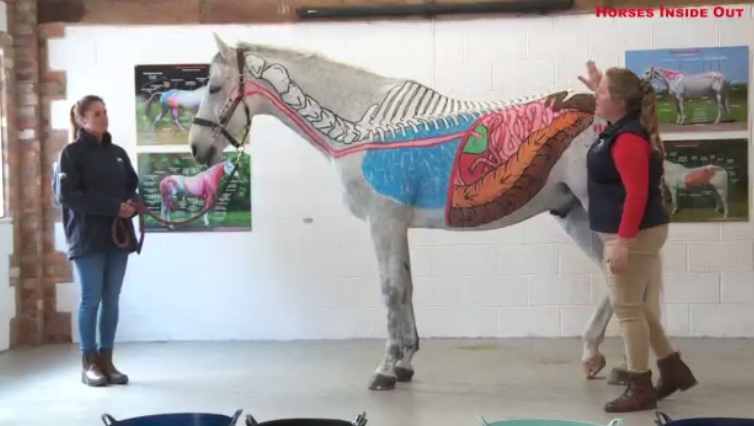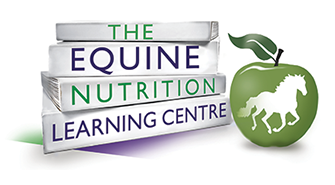Equine Digestive Anatomy, Feeding & Nutrition
This weekend I was really excited to be attending the online seminar ‘Digestive Anatomy, Feeding & Nutrition’
The seminar was hosted by Horses Inside Out and there were 3 speakers during the day.
Anatomist Gillian Higgins
Independent Nutritionist Clare Macleod
Vet Liam Gamble
Although I am not qualified to give dietary advice or recommendations as part of my profession with horses, as a horse owner I was hoping to pick up some practical feeding tips and advice.
And as an equine professional I was looking forward to learning more about the anatomy of the digestive system, the microbiota living within the digestive system and how this relates to the horse on a physical and psychological basis, as this is something I can also have an effect on with Equine Massage Therapy.
The day began with a presentation from Gillian Higgins. One that I was actually a part of the filming day for. I had almost forgotten about this day until I spotted myself on screen.
You can find out more about this day in one of my previous blogs.
Despite the fact that I was actually there when Gillian was presenting this in person, I still made 2 full pages of notes on this section.
Gillian started by explaining some of the evolution of the horse over millions of years and how the horse’s digestive system and physical body adapted to the diet that was available to it.
She then took us through a full journey of the digestive system from the teeth and tongue, right through to excretion.
Some key point from this section that stood out to me:
Saliva production is directly related to chewing
Alkaline saliva is essential for the health of the foregut
Food spends about 2 hours in the stomach when the horse is trickle fed
This can be as little as 20 minutes if the horse is fed a large meal
Stomach acid is produced continually
If the stomach is empty the contents becomes more and more acidic and more liquid
Feeding a double handful of chop before riding can increase the viscosity of the stomach contents and adds saliva (from chewing) which helps to neutralise acid
Most digestion happens in the intestines
The average rate of passage through the small intestine is 90 minutes
Most vitamins, minerals, proteins, fats and carbs are absorbed in the small intestine
Cellulose is broken down in the hind gut which contains microorganisms
This creates heat, keeping the horse warm, and also creates vitamin D
If a horse is fed too much starch to be processed in the small intestine some can end up in the hind gut
Microorganisms require a consistent environment & PH level
If the hindgut becomes to acidic it can kill the microorganisms and lead to guts issues, acidosis, laminitis and other issues
To protect the hindgut always change any feed (including forage) slowly, don’t feed too much starch, avoid stress & anxiety, feed plenty of fibre & forage, take care when feeding medicine & wormers
After Gillian’s excellent presentation there was a chance to ask questions before a quick break and then onto the first of Clare Macleod’s presentations.
I have actually met Clare personally a few times as we have trained with some of the same horse trainers, and I have also used her distance consultation service to get dietary advice for my own horse. However this was the first time I have ever seen Clare present, professionally so I was excited for this.
I really like the way Clare kept her presentation so clear, concise and easy to understand. And also how what she was talking to us about tied in so well with what we had just been learning from Gillian.
Some key points I took home from Clare’s presentation:
A balanced diet supplies all essential nutrients required every day with no overall loss / gain
Bucket feeds should make up shortfalls in the forage to balance the diet
Select appropriate forage
Add products to balance that forage
Sounds so simple doesn’t it! But with so many products and options on the market, and also sometimes depending on your livery situation not having a huge choice in what you feed, how can you make this work on a practical basis?
Clare recommends starting with the horse’s current body condition (body fat) and then asking the question - do we want to change this?
We then know if we want to maintain calorie intake, increase it or reduce it.
Starting with the forage - is it appropriate for the horse?
Nutritive quality
Hygienic quality
Amount fed
For example for an overweight horse you may need to look at mixing some good quality straw into your hay or soaking it for up to 12 hours so that you can feed enough forage to keep the gut happy without adding additional calories to your horse’s diet.
Then looking at balancing that forage. Clare recommends using an off the shelf product that is balanced to average UK forage.
There are 3 options Clare recommends for balancing forage:
1, Multivitamin / mineral supplement
2. Pelleted / meal based balancer
3. Compound concentrate feed
We then learned which would be most suitable for which type of horse and Clare shared with us some of the products on the market that she would recommend as well formulated feeds.
Once you have your balanced diet you can then add salt. This can be provided by a free choice block for horses at rest, or added to the bucket in relation to workload (harder work, more salt required)
Finally Clare mentioned what she calls ‘Therapeutic’ supplements. I like this description as there are so many supplements on the market today it can be a minefield trying to decide what, if any, your horse needs.
Thinking of them as a therapeutic product to add as an addition to the balanced diet helps I think.
Clare has a fantastic Facebook Page where she shares lots of useful nutrition advice on a regular basis, but if you would like to learn more about what I have shared in this blog, and learn in more depth you can also sign up to Clare’s Equine Nutrition Learning Centre which is jam packed with information and articles,
The third speaker of the day was Liam Gamble. Liam is a qualified Veterinary Surgeon and is the Veterinary Director of Protexin Equine Premium.
Liam presented to us about the microbiota in the horse’s gut. He talked to us about what is currently known, what is also known in humans, dogs and cats, and what the future may hold in terms of further research into this area and the possibility of future product developments in this area.
This is the first time I have ever seen Liam and I thought he presented really well and was very interesting. It was also really refreshing that although he is intrinsically linked to the brand Protexin, he didn’t push the products at all, but gave us all the information we needed to make our own minds up about what we might think our own individual horses may need,
Here are a few key points I took home from Liam’s presentation:
70% of the body‘s immune cells are in the gut
The microbiota modulates the immune response
The microbiota also help with:
feeding the gut lining
reducing inflammation
fermentation of fibre & cellulose
breaking down starch
synthesis of vitamins
There is a link between the gut and the brain (The gut brain axis)
Probiotics have been shown to improve mood
Saccharomyces Cerevisiae is currently the only approved probiotic for horses in the UK
Prebiotics feed the probiotic and helps keep them healthy
Dietary change, worming, anti biotics and stress are some of the things that can cause dysbiosis in the gut
Dysbiosis leads to acidosis and a reduction in fibre digestion
Pro and Pre biotics can be used to modify the microbiota and reverse dysbiosis
I think one the messages that can be taken home from all 3 presentations is that the horse’s gut requires a stable environment in order to function ultimately and for our horses to be healthy and comfortable,
In modern day life it is not always possible for our horse’s diets and/environment to remain consistent due to things sometimes out of our control such as a change in a batch of hay, or having to move onto a new pasture to rest the current one. Also stresses such as going to a show or having a new horse join the herd, or having to feed a medicine due to an infection or injury.
We can do our best to keep the diet balanced with our daily bucket feed and then in times of change or stress a probiotic would be useful to give the microbiota some support.
Wow, what a day this was, absolutely jam packed with information. And the benefit of this being an online event and not a live seminar is - all attendees get a whole 14 days to watch it back again, as I am sure we will all hear something we missed the first time round if we watch again.
I really enjoyed this online seminar, it was really well run, well presented and interactive too meaning lots of questions got answered.
Next week Horses Inside Out are running another day long seminar, Training the Brain, Online Day Course with Dr Andrew Hemmings.
If you haven’t gotten your tickets for this yet I would advise getting in quick as I am sure it will be a sell out.
I hope you found this blog useful,







